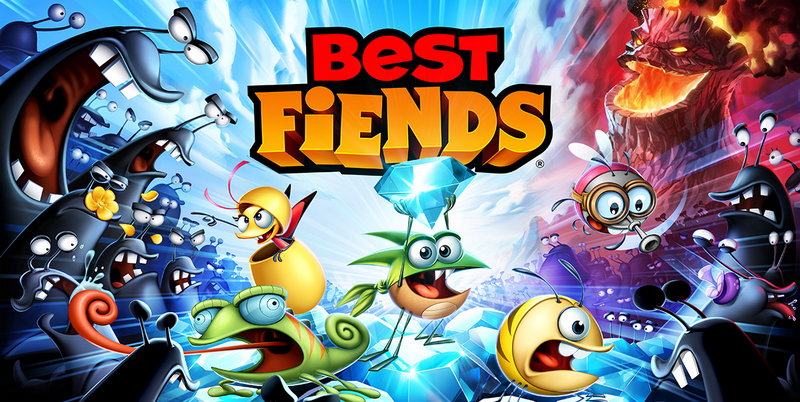It’s almost exactly six years ago that two ex-Rovio employers left the mothership to start their own company. One year later, in October 2014, Best Fiends launched globally and impressively hasn’t strayed far from the US top grossing charts ever since. Currently hanging around spot 90 on that list, Best Fiends is still going strong and has successfully sustained the company’s hundred-something employee headcount all these years. But something new is brewing…
Editor’s Note: This post was originally published by Niek Tuerlings writer at Ludocious.com. Game Designer on June’s Journey at Wooga, Berlin. Disclaimer: The article is the author’s own professional view on Best Fiends. Wooga GmbH isn’t affiliated with this assessment in any way.
Throughout the years, the company’s pipeline has contained multiple Best Fiends games. Unfortunately without much success. Best Fiends Forever, launched in 2016 was a bold genre-switched Idle Game adaptation but was too big of a surprise for the Puzzle audience who knew the Fiends from the initial game. The “lack of gameplay” familiar players must have felt when playing BFF was too much to take.
Then another product, Best Fiends Rivals was announced to be released, again in October, 2 years ago, only to be cancelled after soft-launch numbers showed underperforming results. Marketability was presumably an issue, given the competitive focus of the game and the audience Best Fiends games normally caters to.
Last April, Seriously kicked off Soft Launch for Best Fiends Stars, throwing overboard all risky attempts of fitting different gameplay mechanics into the >$100M franchise. With BFS, Seriously seems to go back to its roots, not adding any twists and hopefully setting up the company for another 5 years at least. Why do another risky genre-switch if you have a working core that you can make a sequel with?
The company should also be more comfortable after being acquired by Playtika last summer, who have been on a warpath during recent years, acquiring multiple casual game studios such as Jelly Button and Wooga. The latter, funnily enough is the company that released the other successful match-3 Linker, Jelly Splash in 2013. (check out Miska’s blast-to-the-past DoF post!)
Given a Soft-Launch is expensive and Christmas is approaching, Best Fiend Stars is expected to globally launch any time between now and mid December.
By making a comparison between Best Fiends and Best Fiends Stars we can see what Seriously decided to keep or change.
But first, especially when you’re not so familiar with the Best Fiends IP, have a look at this animation video:
Boot Camp, A Best Fiends Animation
Best Fiend is definitely something worth talking about. Stemming from Rovio, Seriously knows how to make an IP into a franchise. The company has incredible community management and actively expands the Best Fiends Franchise with high quality animated shorts like the one above. The company is also selling physical merchandise.
Next to this, Best Fiends is truly unique in its field. When looking at GameRefinery‘s top grossing charts, Best Fiends is the only RPG in the top 300 that is catered to be specifically attractive to female audience. It’s a true outlier in a segment full of games like Empires & Puzzles, AFK Arena and the likes.
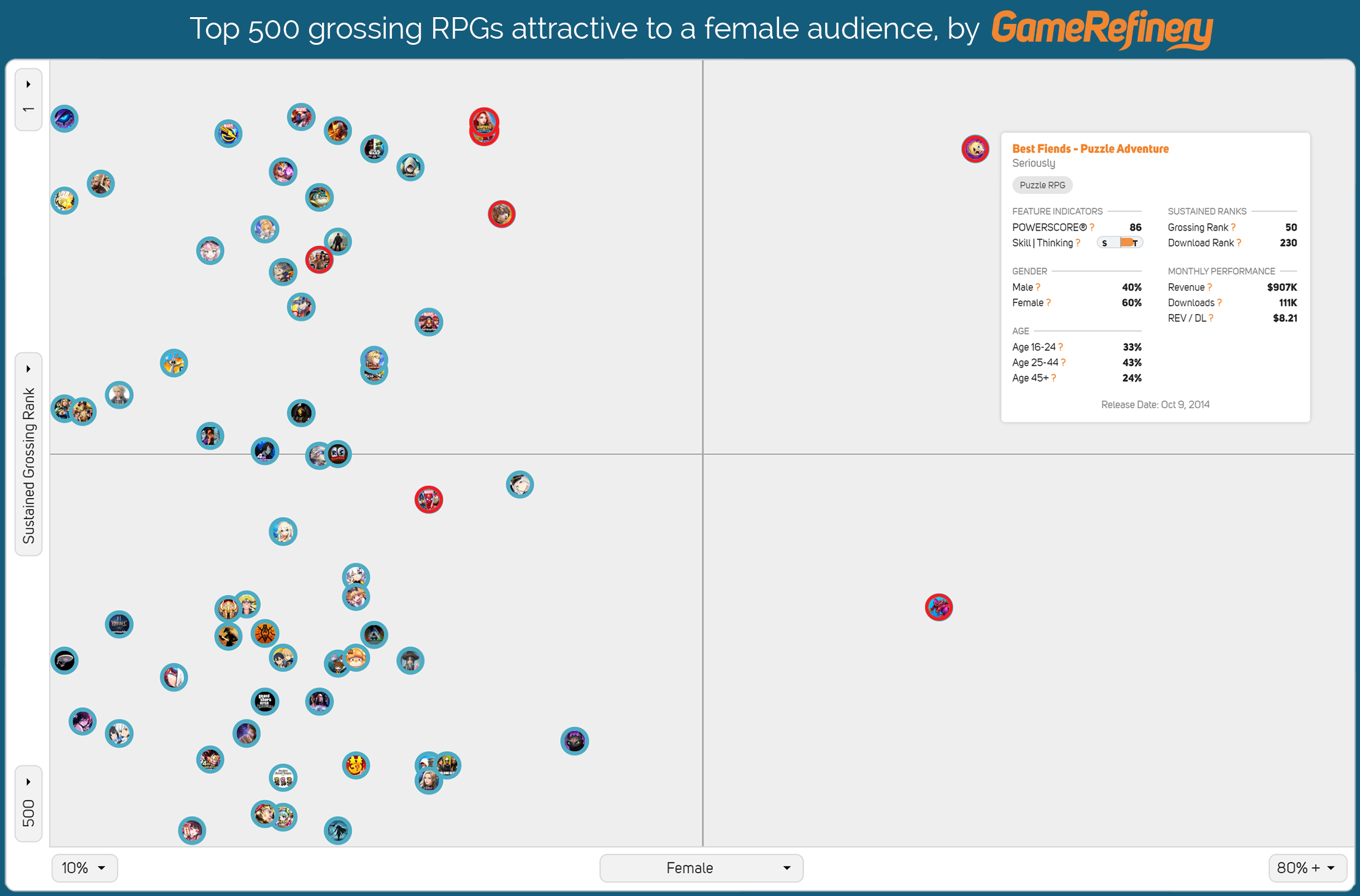 Blue are regular RPGs, Red are specifically Puzzle RPGs (tap to enlarge)
Blue are regular RPGs, Red are specifically Puzzle RPGs (tap to enlarge)The Core Game
As opposed to most match-3 games, Best Fiends has never used the highly popular Candy Crush ‘Swap’ mechanic but the ‘Link’ where the player links long trails of (minimally 3) gems with the same colour instead of simply swapping two gems to get three in a row.
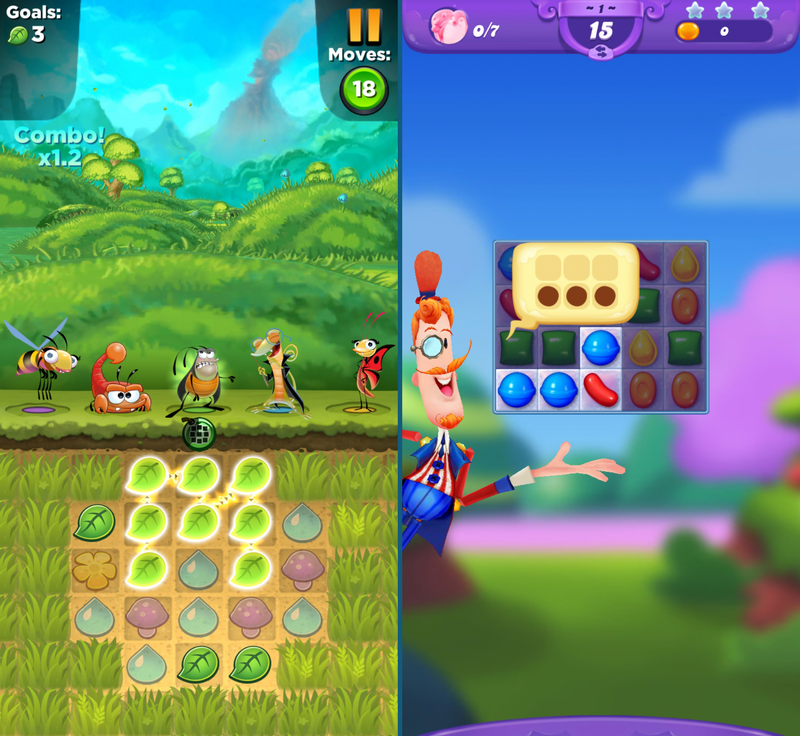
Link v.s. Match (Candy Crush Friends)
You have to have a very good reason to choose Link over Swap since it has two fundamental disadvantages.
The first and most important detriment is that Linkers don’t have auto-matches. Every match requires player input. New gems trickle, sure, but having the luck of 3 gems end up next to each other only means something if the player does something with them afterwards. In matchers these sets of gems match automatically, causing a chain reaction that provides this nice and instant dopamine hit players are craving for. “Luck’s on my side!” is not something that is uttered by many Linker players.
The second disadvantage is that matches (especially optimal ones) take much more calculation to pull off. Casual players generally don’t like to strategise and consider their moves too much. This manifests itself during the moves that make up matching gameplay as well. It’s simply way easier to play suboptimally if you have to make complex shapes of +-10 different gems compared to just swapping 2 gems and let Lady Luck take over.
It wouldn’t have been the craziest idea to have Best Fiends Stars let go of its Linker heritage and exchange it with a Swap mechanic, if only those darn Fiends wouldn’t have been so influential within the core of the game.
With these disadvantages, how is Best Fiends still so fun to play? Two words; Level Design. Seriously seriously has this down! (sorry, I had to make at least one) With the >2000 highly optimised levels from BF, they’ve racked up so much experience with regards to what makes players tick. They can cater to their slightly-more-tactical-but-still-casual audience the best way possible. Here’s one example:
In Best Fiends Stars, practically every level opens up within the first couple of moves. Levels start out highly claustrophobic and transform into comfortably spacious within a handful of moves.
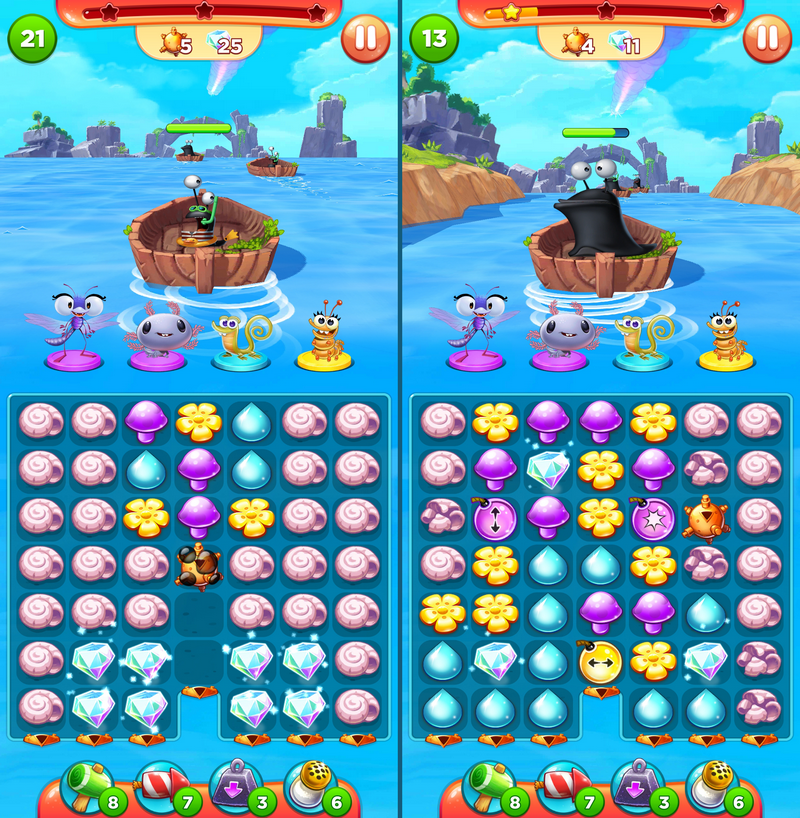
Opening up a level in Best Fiends Stars.
This has a big advantage. This way, the player feels they’ve made good progress really quickly, setting up a psychologically positive mindset. “I’ve got so many possibilities now!” makes a great mentality.
Another thing with levels that open up like these is that they can (and have to) be shorter. Shorter levels (around the ~20 moves range) are generally more pleasant to play since the sunk cost in case of losing is lower. On top of that these levels take less time to design, they feel more snappy and if (like Best Fiends Stars and Toon Blast) the levels are on the easier side it makes for happy players since there is progression every session.
Keep it Simple, Stupid
When comparing Best Fiends Stars with its predecessor, it quickly becomes clear the game is an optimised and decluttered version. The pre-level screen is the most visible example of this. A noticeable element that is kept is the small sale banner below. This has always been a smart move and it’s not surprising it has made the sequel. Players won’t open dedicated Sale screens if they know where it is, but they have to open the Pre-Level screen. It’s not elegant, but it’s definitely working.
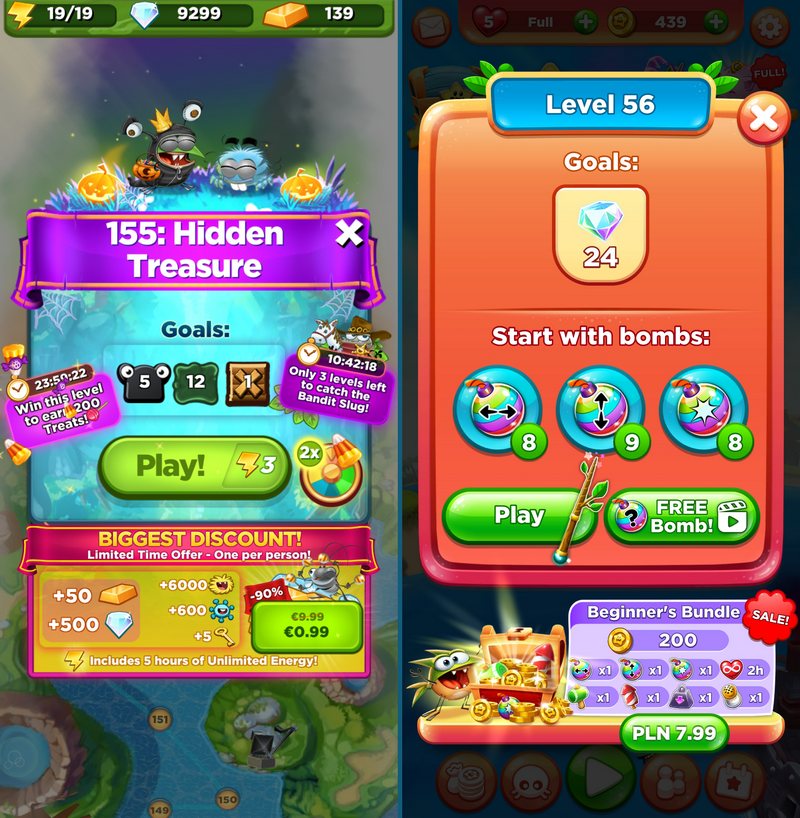 “Where do I look?!” v.s. “Which boosts shall I not use and save ‘for later’ “
“Where do I look?!” v.s. “Which boosts shall I not use and save ‘for later’ “But the main gist is decluttering; BFS is like BF after spring cleaning. It’s clear that Seriously has learned from their most successful competitors and put a much heavier focus on ad-monetisation (FREE Bomb!) and consumable In-App purchases (pre-game boosts).
Progression
The UI and cleanliness of the game are the most visible indicators of Best Fiends Stars’ simplicity, but it’s by far not the most forceful change. For this we have to delve into the way the Fiends work and, Spoiler Alert, subtle as it might seem, it can’t be stressed enough how much impact the following change has to the overall game experience.
The biggest signs of Seriously trying to catering to a much wider market with Best Fiends Stars is that:
- Players can’t choose their Fiends anymore
- Players can’t (actively) upgrade their Fiends anymore
If you have played the original Best Fiends you might have had to read those two points once more, but you’ve read it correctly. All agency with regards to Fiends that was given to the player in the original Best Fiends has been removed in its successor.
First, the upgrading. In Best Fiends, the player gathered a resource called Meteormites, which they could spend freely on upgrading any Fiend of their choice. Since Fiends have specific powers (in both BF and BFS), there were a lot of possibilities for unstrategic players or players who didn’t understand the upgrading mechanic to get stuck. Not having upgraded a specific Fiend can have dangerously negative effects on the player’s ability to win the level. This becomes most obvious when the objective is to kill Snails. Low- level Fiends simply don’t have enough power to remove enough of the Snail’s HP bars.
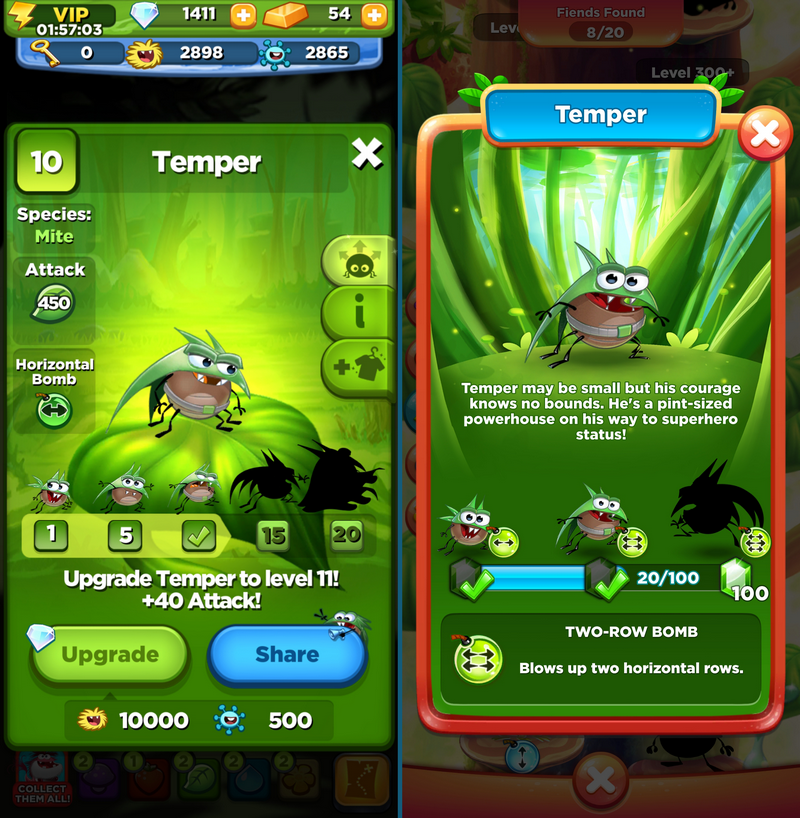
The Upgrade screen in BF (L) and the Fiend Details screen in BFS (R)
To optimise retention of the more casual players, Seriously decided to automatically upgrade Fiends in the successor. In BFS, the player gathers gemstones, which are gathered from chests, which in turn are opened when enough Stars are collected by winning levels. When enough gemstones are found, Fiends of that colour are unlocked, leveled up or evolved. The colour allocation of gems is automatic, which removes the need for Meteormites altogether and makes sure that the player’s Fiends stay up to the challenge.
Now, since all Fiends in BFS are unlocked and become stronger in a fixed and linear matter, there is less need for the player to change which Fiend they would want for any level. In the original game, recommended Fiends were automatically selected as well, depending on the objective of a level, but these Fiends could have been very weak. This is why the players are given the option to change the Fiends they want to use, in case they other Fiends that are stronger.
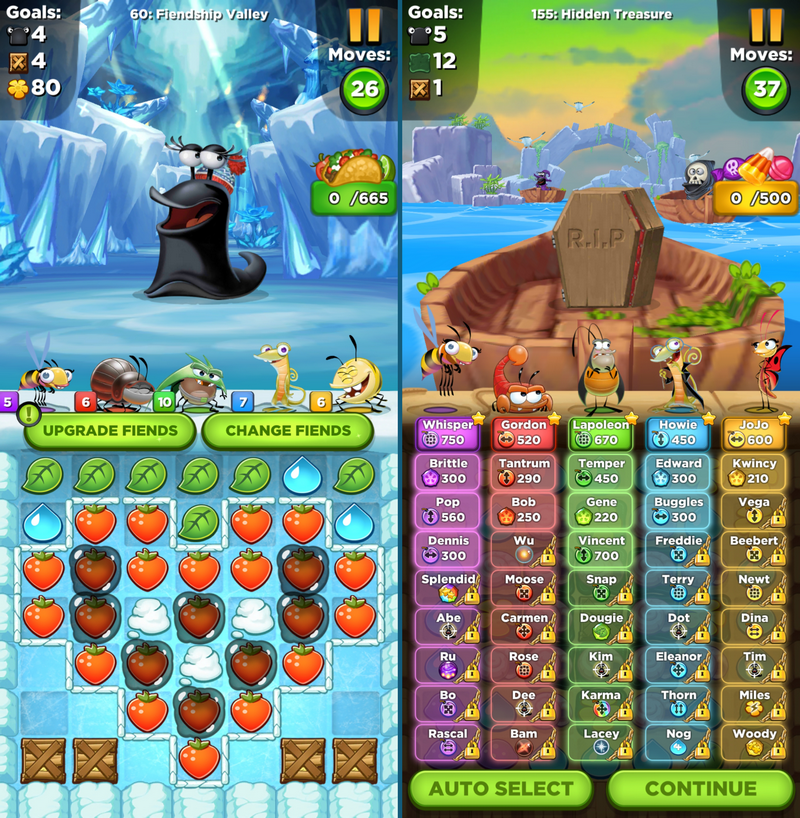
In BFS, recommended Fiends are locked in, removing the friction of potential wrong choices from the player’s experience. This has the added advantage that BFS can support multiple slots of one colour. Not having a Fiend of one colour means that gems of this colour can be entirely omitted from BFS levels as well. This gives the Level Designers much more freedom to create levels that are more closed at start but are opened up due to the cascadey nature of these levels with less different colours.
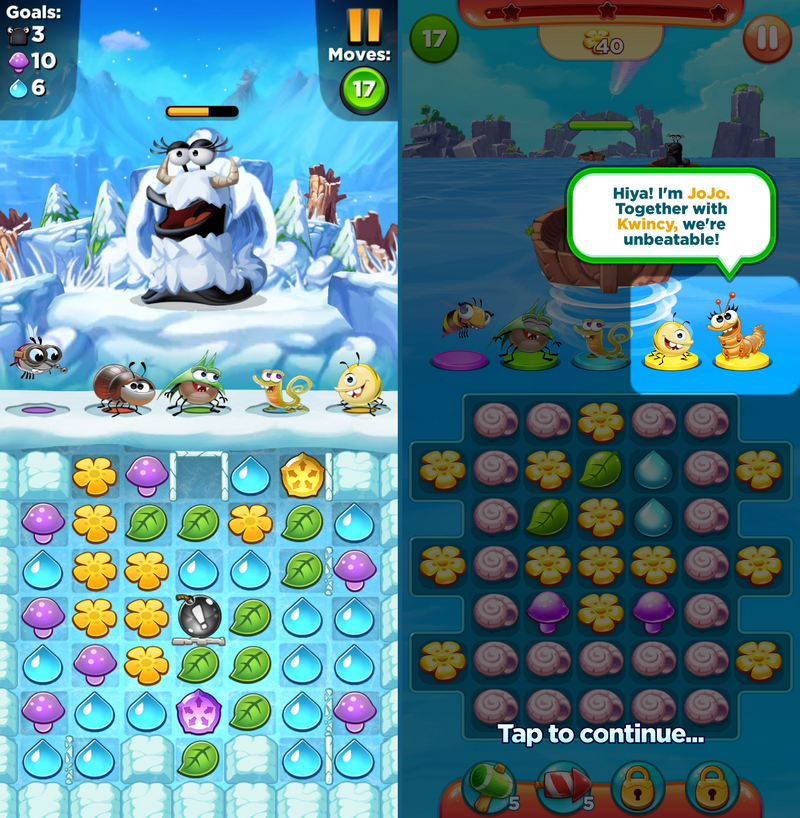
In the above screenshot, having Kwincy as a Fiend in the level makes sure players can match lots of yellow gems, since his special gems transform surrounding gems into yellow ones. Matching lots of yellow gems makes JoJo spawn much more horizontal row bombs.
The way how Fiends work in BFS is a literal game changer and when you think more about it, you could say that Seriously has again released a genre-switched Best Fiends game. The influence players have on how much damage the Snails above the level receive is removed in the successor. This changes the role Snails play in Best Fiends from villains to tactically eradicate to a mere thematic visualisation of the cumulative length of the player’s matches in a level.
This removes Best Fiends Stars from the ‘Puzzle RPG’ category and puts it in the Casual Match-3 space.
Since this is a space that is much more fitting to the art style of the game. This will undoubtedly have a positive impact on CPI and early-day retention.
In other words; Players that love Best Fiends might really not like the successor, but players that would have churned from playing the predecessor have a much higher chance to stick around in the new game.
Another smaller change to the progression systems are that unlike BF, BFS doesn’t feature Energy to play levels but Hearts. Hearts are traditionally consumed upon losing where Energy is consumed when attempting a level. Since Best Fiends started out having Energy but then started giving back sunk Energy upon winning. This effectively makes it work exactly like Hearts so it’s a logical moment to just change to Hearts in the new game and stick with it. Punishing the player when losing works much better than having them pay for trying.
Live-ops
We always hear players talk about wanting to have “things to do”. Somehow they don’t include having a bajillion levels to play into this equation, so we all have to come up with time-limited events to provide a sense of variation and the product being alive. The original Best Fiends tackles this very well. It has about 10 differently themed events that all cater to giving the player various things to do while urging them to Play More and Play Longer.
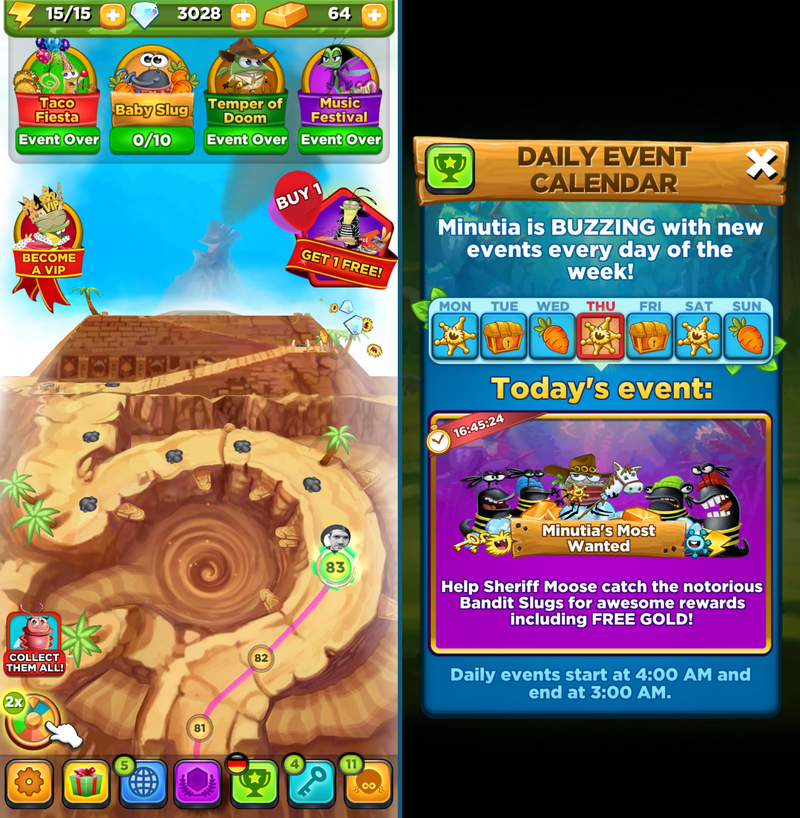
Going into all different events Best Fiends has to offer would take ages, but it’s a masterclass in creating variation and the sense of meaningful rewards in a game loop with inherently limited reward space. You’ve got to play and experience it. But again, there is something to say for purity and cleanliness. After having reached level 100, Best Fiends sometimes has four events and two sales running at the same time, which seems a little excessive. It’s interesting to see if the successor does differently and what the developers have deemed indispensable.
Best Fiends Stars starts out with the following time-limited features:
PvE event – Howie’s Magic Dash
This event is a clean implementation of the modern-day ‘Snowball’ Events we’re seeing in many top grossing games like Matchington Mansion, Homescapes and the likes. Players create win streaks which in turn make the levels easier by providing up to 3 pre-game boosts upon level start.
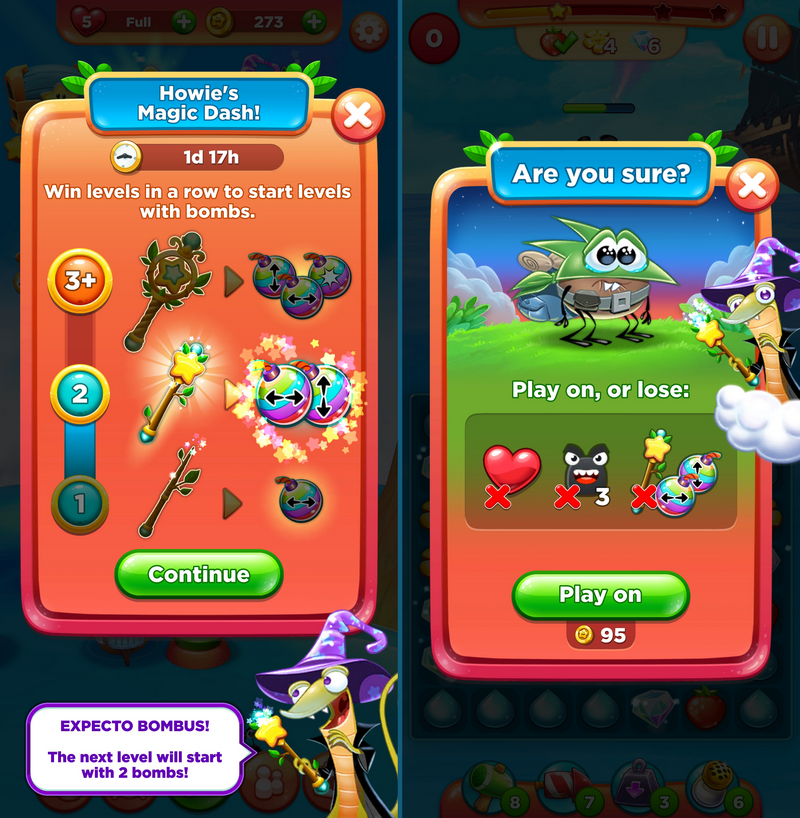
The event doesn’t provide a direct way to monetise, but it puts pressure on the Loss Screen and feeds into the player’s Loss Aversion. Players are confronted with what they will lose when they won’t buy more moves to play on, and this includes Howie’s win streak boosts. “If you don’t keep playing now, the next time you try this level, it will be even harder!”
PvP event – Gene’s Star Chase
The other event BFS contains is built around competition. It’s very simple: all Stars players collect are tallied and visualised in a leaderboard. At the end of the event, players with the most Stars get rewards. This gives competitive players the necessary nudge to try and beat levels as well as they can and Play More. Since levels can’t be replayed to get more Stars, it does generate the feeling of Lost Opportunity if only one or two Stars are collected.
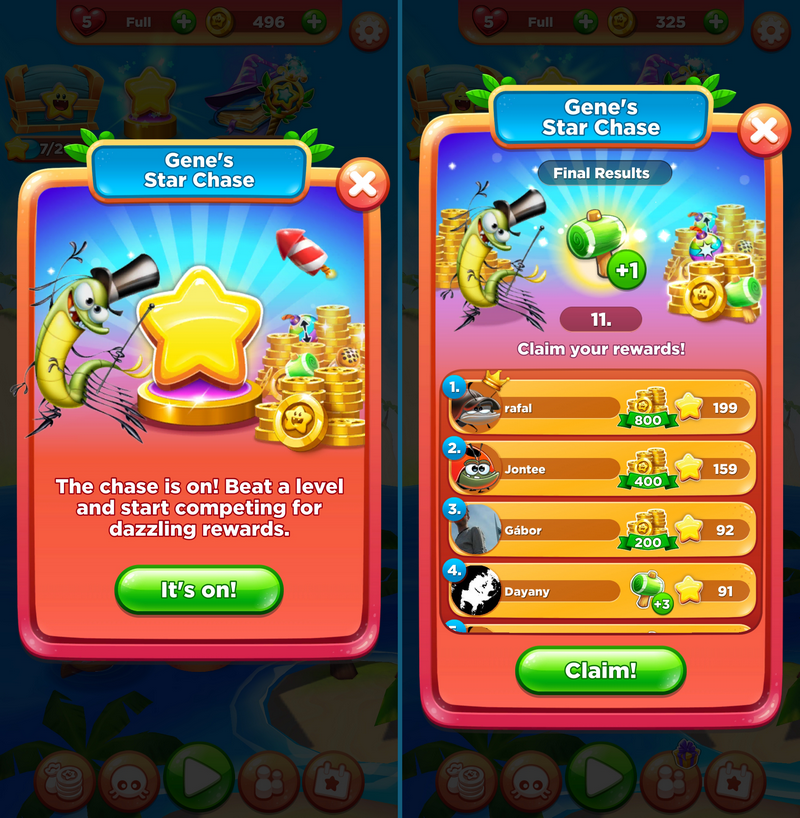
Sales
Some classics can’t be skipped. BFS launches with one boost sale and the Piggy Bank feature. The latter has been popping up in about 50% of all top grossing games during the last few years. It usually works well and can be seen as low-hanging fruit, so why not add it to the MVP?
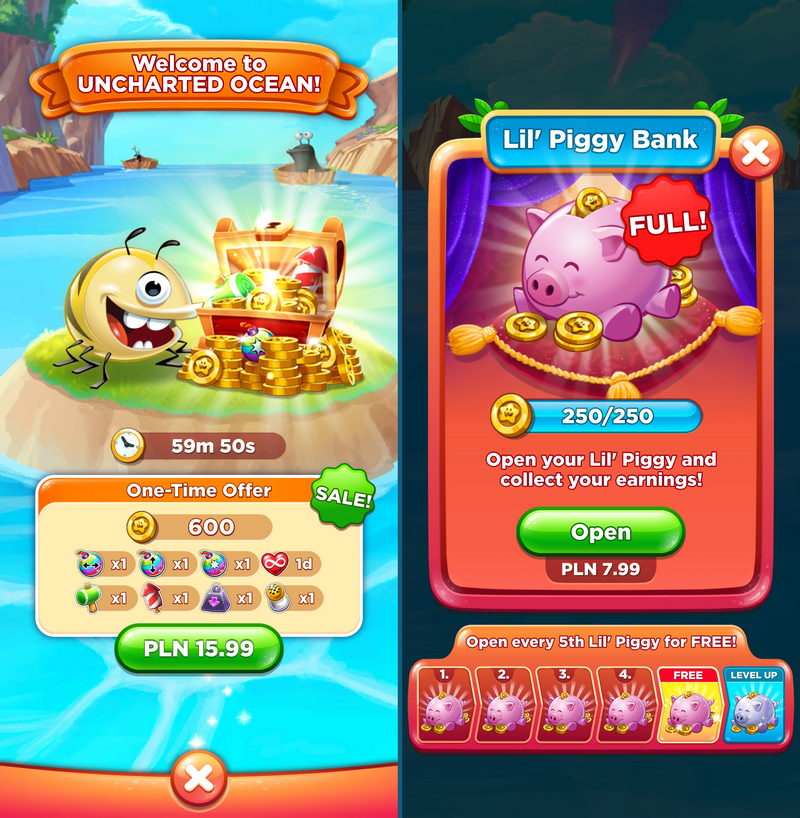
Disclaimer: the Piggy Bank doesn’t actually always work, it depends on the way of implementation and small nuances within, but the classic implementation as seen in BFS does hardly ever fail.
These live-ops ingredients are seen by Seriously as the essentials to launch with and agreed; it’s a neat selection of features. The game could have used one more kind of event to push the non-competitive players into Playing More as well, but there’s no doubt Seriously will eventually add this after BFS launches globally.
What is smart about the two existing gameplay features is that they are both themed using specific characters (Howie & Gene). This makes them easily distinguishable and moreover; it capitulates on what makes the Best Fiends IP so appealing.
Modern-day improvements
Next to the obvious things like smoother animations, better graphics and the presumably shiny new code base there is one more thing Best Fiends Stars does differently than its 5 year old sister: Social. It might not come as a surprise, but the game’s dependency on Facebook has been removed in its entirety. This must be a huge relief for the Game Designers behind BFS since now they can count on the entire player base to be able to enjoy the game’s social features instead of the usual ~30% of players that are connected via Facebook.
Seriously has not missed the market’s trend seeing more and more developers adding Guild mechanics to their casual games and comes with an integrated Teams feature for all players. Where Best Fiends still sends social gifts through Facebook, Best Fiends Stars players can join Teams. Within Teams they can share gifts, chat, add friends and see World and Local leaderboards fully integrated into their game.
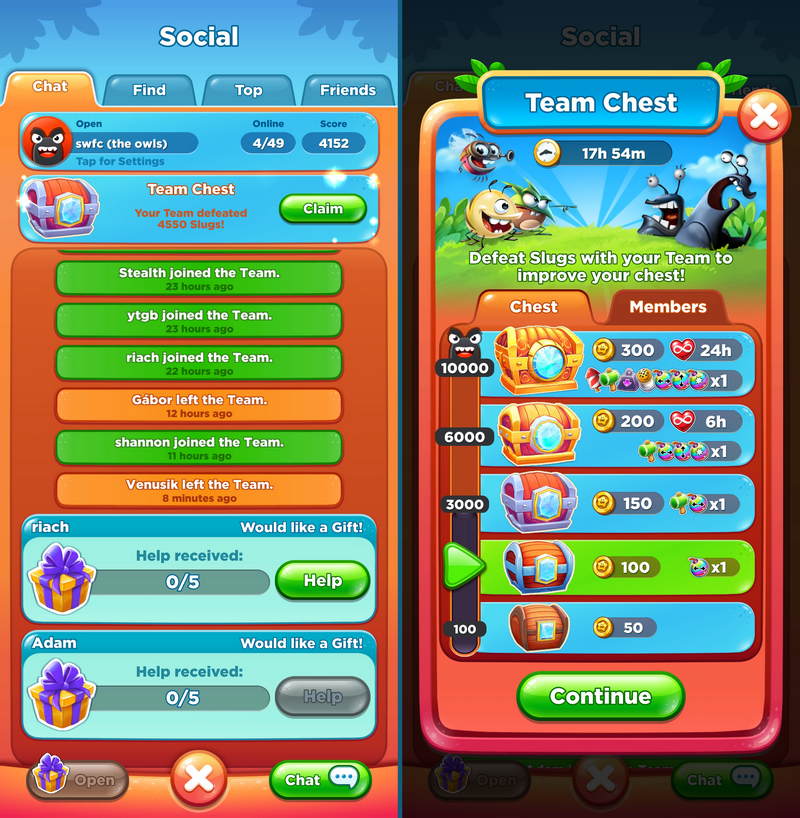
It also features a common goal, which is boosting the Team’s chest that can be opened once in a while. There is no Team v.s. Team competition yet, although this should logically be in the pipeline already.
To Conclude…
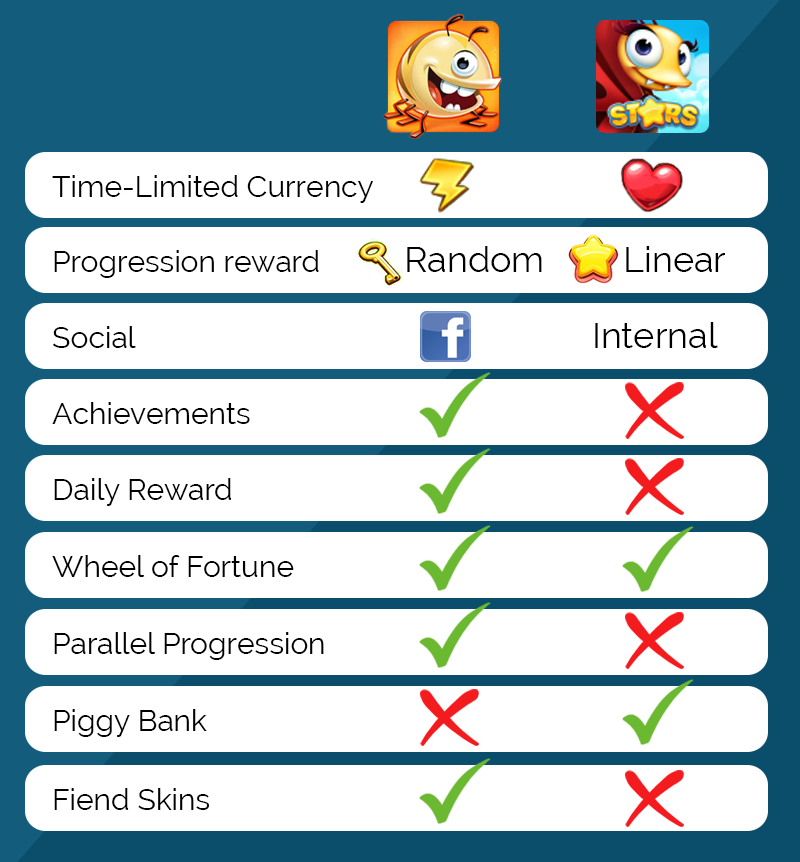
Looking at the way of execution as analysed above, it’s very likely we can see Best Fiends Stars being released very soon. It’s a safe and thoughtful implementation of features and taps into a new segment of the market. CPIs can be kept low through cross-promotion and the fame of the IP. It’s not going to be loved by the entire Best Fiends player base since it’s actually a much more casual game. This is not bad at all, since the original Best Fiends is still doing well and it reduces market cannibalisation, which could be pretty severe if BFS would have the same depth as the original game, given its unique place in the market.

